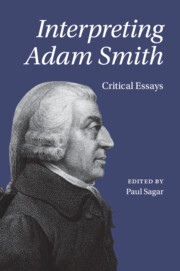Book contents
- Interpreting Adam Smith
- Interpreting Adam Smith
- Copyright page
- Contents
- Contributors
- Acknowledgements
- Abbreviations of Works by Adam Smith
- Introduction
- 1 Smith Scholarship
- 2 The Wealth of Nations as a Work of Social Science
- 3 Adam Smith’s “Industrial Organization” of Religion
- 4 Talking to My Butcher
- 5 What Did Adam Smith Mean? The Semantics of the Opening Key Principles in the Wealth of Nations
- 6 Adam Smith and Virtuous Business
- 7 Adam Smith and the Morality of Political Economy
- 8 A Moral Philosophy for Commercial Society?
- 9 Adam Smith, Sufficientarian
- 10 Narrowing the Scope of Resentment in Smith’s Theory of Moral Sentiments
- 11 Adam Smith
- 12 “Much Better Instructors”
- 13 Sophie de Grouchy as an Activist Interpreter of Adam Smith
- 14 Adam Smith and the Limits of Philosophy
- Bibliography
- Index
1 - Smith Scholarship
Past, Present, and Future
Published online by Cambridge University Press: 14 September 2023
- Interpreting Adam Smith
- Interpreting Adam Smith
- Copyright page
- Contents
- Contributors
- Acknowledgements
- Abbreviations of Works by Adam Smith
- Introduction
- 1 Smith Scholarship
- 2 The Wealth of Nations as a Work of Social Science
- 3 Adam Smith’s “Industrial Organization” of Religion
- 4 Talking to My Butcher
- 5 What Did Adam Smith Mean? The Semantics of the Opening Key Principles in the Wealth of Nations
- 6 Adam Smith and Virtuous Business
- 7 Adam Smith and the Morality of Political Economy
- 8 A Moral Philosophy for Commercial Society?
- 9 Adam Smith, Sufficientarian
- 10 Narrowing the Scope of Resentment in Smith’s Theory of Moral Sentiments
- 11 Adam Smith
- 12 “Much Better Instructors”
- 13 Sophie de Grouchy as an Activist Interpreter of Adam Smith
- 14 Adam Smith and the Limits of Philosophy
- Bibliography
- Index
Summary
This chapter situates Smith scholarship in a long historical view. It highlights the kaleidoscopic nature of reading and writing about Smith from the eighteenth century to the present. A brief survey of the early reception of Smith’s works in the anglophone world demonstrates how and why Smith was initially read as a practical resource before being transformed into an intellectual and political authority. Interpretive problems like “Das Adam Smith Problem” and the Chicago School Smith, introduced in the nineteenth and twentieth centuries, then became starting points for critical and revisionist historiography. Contemporary scholarship has been marked by several distinctive features: an increasing interest in Smith as a philosophical thinker, the centrality of The Theory of Moral Sentiments, engagements with Smith to proliferate new defenses and critiques of liberalism, and the reformulation of older categories of analysis. I suggest that the ambiguity and contestability of Smith’s intentions as well as the slipperiness of the conceptual categories that he inspired have engendered shifting meanings, emergent problematics, and the enduring political relevance of his works and ideas.
Information
- Type
- Chapter
- Information
- Interpreting Adam SmithCritical Essays, pp. 3 - 20Publisher: Cambridge University PressPrint publication year: 2023
